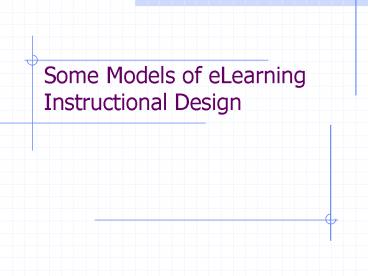Some Models of eLearning Instructional Design - PowerPoint PPT Presentation
1 / 15
Title:
Some Models of eLearning Instructional Design
Description:
A model provides a conceptual underpinning and ... Boutique Course Development. This 'boutique' model is one in which the instructor contacts an instructional ... – PowerPoint PPT presentation
Number of Views:144
Avg rating:3.0/5.0
Title: Some Models of eLearning Instructional Design
1
Some Models of eLearning Instructional Design
2
Model Contents
- A model provides a conceptual underpinning and
suggested methods for approaching the work of
eLearning curriculum design.
3
Typical Steps in eLearning Content Provision
- Learning needs analysis specification of
learning objectives - Curriculum design selection and organization of
courseware (learning content creation) - Curriculum delivery courseware delivery using
appropriate media - Curriculum evaluation conformance of curriculum
design and delivery to learning objectives
(Anane, Crowther, Beadle and Theodoropoulos,
2004, n.p.)
4
Boutique Course Development
- This boutique model is one in which the
instructor contacts an instructional designer for
targeted help in launching an online course.
(A.W. Bates and G. Poole, pp. 140 141)
5
Collegial Materials Development
- This model suggests that several academics work
collaboratively to create online or multimedia
educational materials. These members may be from
one department or from cross-field departments.
(A.W. Bates and G. Poole, 2003, p. 141)
6
Project Management
- Project management has a defined set of
resources, a timeline, and a clear deliverable.
This may involve a team or an individual, who may
build for a group of stakeholders.
7
Lone Ranger Approach
- This approach involves one instructor with
certain online learning development goals who
goes it alone. The various strengths and
weaknesses of that instructor will affect the
course outcomes. It is said that university and
college cultures support this approach with their
funding structure.
8
Automated Course Development
- Automated courses try to engage learners
cognitively and emotionally. The latter aspect of
this is done through the personalization of the
learning through pedagogical /learning agents or
automated bots or talking heads. Games may be
added to create particular simulations.
9
Cultural Neutrality
- Recent research has addressed issues of cultural
neutrality in the creation of inoffensive
curricular materials. - Another approach has been to culturally tailor
a curriculum to a particular learning group.
10
Cultures of Curriculum
- The concept of the cultures of curriculum asks
what underlying assumptions and implications
there may be to how a curriculum is created.
While this was not designed with online learning
in mind per se, this model by P.B. Joseph
surfaces important questions. The following are
some broadly paraphrased questions.
11
Cultures of Curriculum (cont.)
- What statements synthesize major beliefs in this
culture of curriculum? - What are the goals of education?
- What are the forces, events and ideas that
influenced this culture of curriculum? - What are the roles of instructors, and how do
they facilitate learning? - What is the subject matter, and how is it
organized?
12
Cultures of Curriculum (cont.)
- What is the online classroom environment?
- Who plans the curriculum, and who has the power
to make decisions? - How should students be assessed? How is the
success of the curriculum determined? - What problems or challenges do teachers face when
they implement this culture of curriculum? - What problems are inherent in the vision of this
curriculum? What are the blind spots not
perceived by advocates of this culture of
curriculum?
13
Explicit, Implicit and Null Curricula
- Whats said? Whats not said? What is not even
noticed? - The above question encapsulates the concepts of a
curricula that is unexplored and has embedded
assumptions.
14
References
- Anane, R., Crowther, S., Beadle, J., and
Theodoropoulos, G. (2004) eLearning Content
Provision. IEEE. Proceedings of the 15th
International Workshop on Database and Expert
Systems applications (DEXA 04). - Bates, A.W. and Poole, G. (2003) Effective
teaching with technology in higher education
Foundations for success. San Francisco
Jossey-Bass Publishers. - Joseph, P.B., et al. (2000). Cultures of
curriculum. Mahwah Lawrence Erlbaum
Associates, Publishers.
15
Conclusion
- What sort of curricular design method would make
sense for you and your work situation? - Would there be a more ideal method? Is there a
way for you to make that happen?































